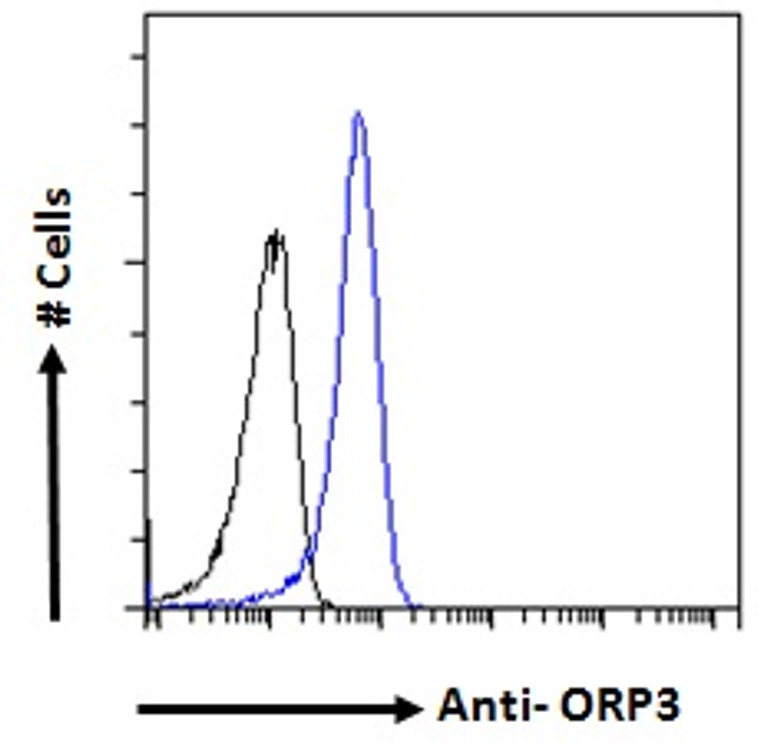| Host: |
Goat |
| Applications: |
Pep-ELISA/IF/FC |
| Reactivity: |
Human/Mouse/Rat/Dog/Pig/Cow |
| Note: |
STRICTLY FOR FURTHER SCIENTIFIC RESEARCH USE ONLY (RUO). MUST NOT TO BE USED IN DIAGNOSTIC OR THERAPEUTIC APPLICATIONS. |
| Short Description: |
Goat polyclonal antibody anti-ORP3 (N-Term) is suitable for use in ELISA, Immunofluorescence and Flow Cytometry research applications. |
| Clonality: |
Polyclonal |
| Conjugation: |
Unconjugated |
| Isotype: |
IgG |
| Formulation: |
0.5 mg/ml in Tris saline, 0.02% sodium azide, pH7.3 with 0.5% bovine serum albumin. NA |
| Purification: |
Purified from goat serum by ammonium sulphate precipitation followed by antigen affinity chromatography using the immunizing peptide. |
| Concentration: |
0.5 mg/mL |
| Dilution Range: |
IF-Strong expression of the protein seen in the cytoplasm of A431 cells. 10µg/mlFC-Flow cytometric analysis of A431 cells. 10ug/mlELISA-antibody detection limit dilution 1:32000. |
| Storage Instruction: |
Store at-20°C on receipt and minimise freeze-thaw cycles. |
| Gene Symbol: |
OSBPL3 |
| Gene ID: |
26031 |
| Uniprot ID: |
OSBL3_HUMAN |
| Immunogen Region: |
N-Term |
| Accession Number: |
NP_056365.1; NP_663160.1; NP_663161.1; NP_663162.1 |
| Specificity: |
This antibody is expected to recognise all reported isoforms (NP_056365.1; NP_663160.1; NP_663161.1; NP_663162.1). |
| Immunogen Sequence: |
MSDEKNLGVSQKL |
| Post Translational Modifications | Phosphorylation is enhanced in vitro by phorbol-12-myristate-13-acetate (PMA), forskolin and calcium ionophore A23187. Phosphorylation seems to be stimulated in conditions of low cell-cell (or cell-matrix) adhesion. |
| Function | Phosphoinositide-binding protein which associates with both cell and endoplasmic reticulum (ER) membranes. Can bind to the ER membrane protein VAPA and recruit VAPA to plasma membrane sites, thus linking these intracellular compartments. The ORP3-VAPA complex stimulates RRAS signaling which in turn attenuates integrin beta-1 (ITGB1) activation at the cell surface. With VAPA, may regulate ER morphology. Has a role in regulation of the actin cytoskeleton, cell polarity and cell adhesion. Binds to phosphoinositides with preference for PI(3,4)P2 and PI(3,4,5)P3. Also binds 25-hydroxycholesterol and cholesterol. |
| Protein Name | Oxysterol-Binding Protein-Related Protein 3Orp-3Osbp-Related Protein 3 |
| Database Links | Reactome: R-HSA-192105 |
| Cellular Localisation | Endoplasmic Reticulum MembranePeripheral Membrane ProteinCytoplasmCytosolCell MembraneCell ProjectionFilopodium TipNucleus MembraneCo-Localizes With Osbpl6 At Contact Sites Between The Plasma Membrane And The Endoplasmic Reticulum |
| Alternative Antibody Names | Anti-Oxysterol-Binding Protein-Related Protein 3 antibodyAnti-Orp-3 antibodyAnti-Osbp-Related Protein 3 antibodyAnti-OSBPL3 antibodyAnti-KIAA0704 antibodyAnti-ORP3 antibodyAnti-OSBP3 antibody |
Information sourced from Uniprot.org
12 months for antibodies. 6 months for ELISA Kits. Please see website T&Cs for further guidance







